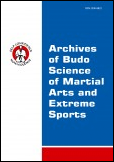2016, Volume 12, Issue 1
Correlations between anthropometric indicators, heart rate and endurance-strength abilities during high-intensity exercise of young women
Robert Podstawski1, Piotr Markowski2, Dariusz Choszcz2, Piotr Żurek3
1Department of Physical Education and Sport, University of Warmia and Mazury in Olsztyn, Olsztyn, Poland
2Department of Heavy Duty Machines and Research Methodology, University of Warmia and Mazury in Olsztyn, Olsztyn, Poland
3Department of Physical Education in Gorzów Wielkopolski, University of Physical Education in Poznań, Poznań, Poland
Author for correspondence: Robert Podstawski; Department of Physical Education and Sport, University of Warmia and Mazury in Olsztyn, Olsztyn, Poland; email: podstawskirobert[at]gmail.com
Full text
Abstract
Background and Study Aim: The optimum level of the endurance-strength abilities is necessary to perform professional activities, and many other daily tasks. The objective of this study was the correlations between anthropometric indicators, BMI, heart rate and endurance-strength abilities of young sedentary women.
Material and Methods: Seventy-two female students of the University of Warmia and Mazury in Olsztyn (Poland) with the mean age 20.6 ±0.66 years were tested. The participants’ body mass, body height, length of upper and lower limbs, and BMI were determined. Their endurance-strength abilities were measured in the 3-minute Burpee Test (3MBT). The students’ heart rate (HR) was measured immediately before and after the test, and 30-, 60- and 90 seconds after the test. The results were processed statistically and correlation coefficients r were calculated to determine the relationships between anthropometric indicators, HR and the number of completed 3MBT cycles.
Results: The average 3MBT result was 48.58 cycles/3 minutes, the participants’ HR increased to 181.92 b*min–1, with average increment of 71.88 b*min–1. Heart rate values in successive measurements (T2 – T5) were significantly (p<0.05) higher than resting HR (T1). Heart rate values decreased significantly (p<0.05) every 30 seconds after the test (between T2:T3, T3:T4 and T4:T5) to reach 150.96 b*min–1 on average after 90 seconds. The number of completed 3MBT cycles was significantly negatively correlated with the participants’ body mass, height and BMI.
Conclusions: An increase in anthropometric indicators, including body mass and height, and BMI contributes to a significant decrease in endurance-strength abilities of young women performing the 3MBT. The significant increase in HR and high HR values immediately after exercise indicate that the test involves very high levels of physical exertion.
Key words: BMI, HR, Burpee test, physical exercise, exertion





